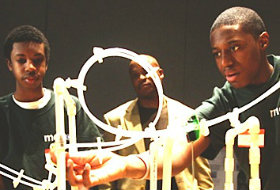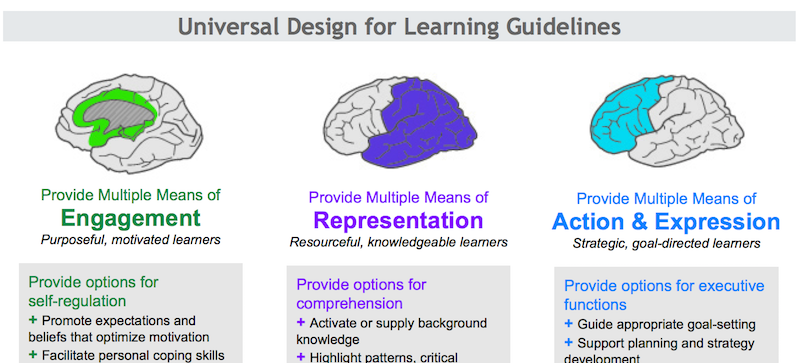What Is Your Classroom’s Learning Foundation?
A MiddleWeb Blog
 Teachers, what do you consider to be the foundation of all learning in your classroom?
Teachers, what do you consider to be the foundation of all learning in your classroom?
Before you read any further, jot your thoughts on a sticky or a piece of scrap paper (no glancing ahead, please. Keep your thoughts authentic to you).
Need a hint? 
I hope you’ve given my question some serious thought and jotted down the word or phrase that describes what you believe to be the foundation, the core, the underpinning of all learning in any classroom.
There’s no absolute right answer, but here’s what I think…
The Place to Start

I’m not talking about checking to see if students are sitting up, facing forward, following directions, and speaking when spoken to. No! I’m not even talking about the kind of engagement where students are participating in group activities and discussions when prompted.
Don’t be lulled into a false sense of satisfaction by these outward appearances. We need to get much deeper. I’m talking about a shaking-it-up kind of way to measure and then bolster student engagement, so each learner in your room has the opportunity to personally connect and comprehend.
When you have some time, check out this article at Edutopia that helps us answer the question How do we know when students are really engaged? This article is sure to guide you in assessing the teaching and learning moves in your classroom. It begins by citing a study that found “of 1,500 classrooms visited, 85 percent of them had engaged less than 50 percent of the students.”
Meaningful Student Engagement

These four goals are driven by natural human needs that result in positive interactions with learning. The authors’ research led them to believe that all learners must have:
- Success—to experience mastery
- Curiosity—to find answers to their questions—and to understand
- Originality—to find ways to express themselves that demonstrate their personality, talents, and strengths.
- Relationships—to collaborate with others
And the result of providing these four goals leads to
- Energy—When learners’ intrinsic motivation increases in such a way that the productive energy needed to push through challenges, face confusion, and embrace the learning process takes hold.
What Co-Teachers Can Do
-
- In general, when thinking about engagement, use the UDL Guidelines to create a framework for you to think about how to work toward instilling intrinsic motivation. When you notice the Engagement column of the guidelines, begin with options for recruiting interest—then move toward options for sustaining effort and persistence—and finally see the top of the guidelines for options for self-regulation. This UDL framework allows learners to become self-regulated, intrinsically motivated learners with the external efforts and decisions we make as we design our classroom environment.
- Edutopia comes to the rescue again as we search for strategies to spark each student’s curiosity—check out this link.
- But Edutopia doesn’t stop there! Get a refresher on How Curiosity Enhances Learning.
- Provide specific, meaningful feedback to guide learners toward mastery. Use these strategies (once again at Edutopia!) to spark up your daily routines.
- Looking for more tips for providing specific, meaningful feedback? Here’s 20 more tips and strategies—provided by TeachThought.
- Let your creativity take charge as you provide multiple ways for students to express their understanding. Once again, the UDL guidelines provide the structure we are looking for! Check out the Action and Expression column. You will get tips for guiding the strategic networks of each brain in your classroom!
- Incorporate plenty of meaningful cooperative learning activities. But make sure students are not just going through the motions. Provide opportunities for students to feel valued and to extend their knowledge base as they learn alongside their peers. Check out this Educational Leadership article at ASCD to Make Cooperative Learning Powerful (it’s from the “Instruction That Sticks” issue!).
Now Watch the Sparks Fly!

And here’s a huge bonus: the energy in your room will be felt around the entire school, because that’s how powerful the learning process can be.
One final thought before I call this post done for now…
Be sure to incorporate true growth mindset belief systems to guide your students to push through the natural challenges that must happen in all positive learning experiences. Did you notice I said “true” growth mindset? Well, here’s why. Be sure to keep it real!
So what did you jot down in the beginning of this post? What do you believe to be the foundation of all learning? Does student engagement make sense as the “Big Bang” of learning? Please share your thoughts—and let’s create a solid foundation for all!




































Thanks Elizabeth —— engagement brings back the Montessori approach
“Tell me and I will forget, show me and I might remember, but INVOLVE me and I will understand.” One of our goals at Piclits.com is to provide the teacher with a tool (if use properly) engages each student in writing. Writing being a literacy skill as important as reading. Actually, when you write, you are actually reading. There are five tutorials on our FAQ tab on the home page. Check out the two minute one that occurred in a ESL class.
Thanks again — Terry Friedlander, founder (www.piclits.com )
( terry@piclits.com ) :)
Thank YOU Elizabeth – this is Dr. Pete Post once again and I would like another group of my master’s students in special education to respond to the wonderful challenges and resources that you have presented here. I look forward to seeing what they have to share as well.
Elizabeth ——— your feedback would be terrific. It would take some time to explore the site, but if time permits, your thoughts and ideas would be more than welcome. Terry
My initial thoughts when asked what was the foundation for learning was that an environment of inspiration and rapport needs to be established. I think that this leads students to want to come into your classroom and be a part of something. The age old questions that students ask, “Why do I need to learn this? When will I ever use this?” are valid. How does the material we want to teach help them in their lives? Some lessons are basic to all of us, but others really need to be tied in to what their goals, interests, and plans are for the future. If we can tap into who they are, what motivates them, and look to incorporate some of these ideas into our classroom, then I feel the students feel heard and valued as an active participant in the process of learning.
I suppose this isn’t so different from engagement, but maybe a different way of saying it. If the students aren’t going to be involved in the process of learning, it holds no long lasting value. This is certainly an important element to teaching and learning within all areas of life, whether the formal classroom or elsewhere.
My initial thoughts about my foundation for learning is expectations. I believe setting the expectation is my foundation for any lesson. However, after reading this article, I realized that student engagement is how to meet the expectations I set. I remember many lessons that I have taught that have gone great because the students were so engaged and motivated to learn. Also, when students are engaged, I believe they remember and understand the lesson better because they’re interested about the topic. I still believe that expectations need to be addressed before lessons are taught. However, when the lessons are engaging class management is almost an after thought.
Bill-I really did write my words on a piece of paper and they were expectations and respect! I enjoyed the article and can honestly say that student engagement is the key. Students need to feel a direct connection to the teacher, their peers, the materials, and the subject matter. It is a small community and it cannot run successfully without each member contributing . Of course, as in all communities, there must be rules to follow and an expectation that each person treats the other with respect. When these things meld together learning is the only option. The students will learn from the teacher and from each other.
I definitely agree that student engagement is key. I teach students with severe autism and unless they are buying into what I am about to teach or do I’ve lost them. They will be running away from the table, flopping to the floor, or just staring off. It’s all about getting their attention, keeping their attention, and creating an energy powerful enough to keep my students motivated. I feel like this can get tricky for me because I teach the same lesson multiple times over the course of a few weeks in order for my students to benefit from the materials. It’s at times hard for me to be engaged in the lesson because we’ve done it so many times, and that is how I know its time to change up the materials and present the same information in a new way!
I wrote my thoughts down before I continued reading, they were engagement, readiness, and safe environment for learning. I teach at a middle school setting. I have students for 43 minutes to teach reading, or language, if there is no engagement, then like the blog explains there is no experience ands students learn from experiences. I am always telling the students, to not be zombies, to engage in what I am saying or another teacher is saying, to pay attention to what other classmates are saying and doing to learn from each other. Because I teach different subjects, sometimes I may focus on engaging students in one lesson and forget the other content area. This blog reminded me my teaching is a work in progress and there is always room for improving.
When I first read your question about the foundation of learning, the first thing that came to mind was: well-thought out lesson planning.This was a great article and I definitely agree, my classroom would be NOTHING without student engagement. As a high school art teacher, my classroom environment is a bit more loose than most. Students move around the room freely while working on projects, I play music over my speakers, and in some classes I allow students to listen to their own music through headphones. If my room was absolutely silent with no one moving I would go crazy! So when I introduce lessons to the class I like to have fun visuals, lots of examples including physical forms and videos. I ask students engagement questions as I go to incorporate prior knowledge and get them excited about what we’ll be making next. If students just sat still, staring blankly at me, It would bother me because it’s not the reaction I want, so it would make me self-evaluate to figure out HOW I could have gotten them more engaged. I think this website will be a great resource for me for middle school students, there are so many helpful posts. I look forward to reading more from you.
While reading the article my words were expectation, participation, and community. I believe each teacher should have a certain level of expectation for their students, which should be success. What success looks like may vary from teacher to teacher. I believe in order to have a successful learning environment clear expectations need to be established to promote participation which will lead to a sense of community. I do agree that engagement is definitely the key. I agree with Bill and Kate that when students are engaged and motivated meaningful learning can take place within the classroom community. As we teach our students we are also learning from them. We need to be willing to adapt our instruction to fit the needs of our students and to continually engage them to promote educational growth.
My initial thought was respect. I feel like students must respect the teacher and respect other students. If respect is not present in the classroom, rules and expectations may be broken, and less learning will take place. I remember my first year teaching, my mentor put a huge emphasis on rules and procedures. We practiced so much the first few weeks of school.
For some reason, student engagement did not come to my mind. After reading that, I was like, “Oh, well, of course!” Student engagement is definitely the key to create meaningful learning in the classroom. I love seeing the faces of my students when I am teaching a lesson. I teach younger students, so it is very apparent to me when they are engaged and when they are not. It is so important to keep them engaged, just to keep their attention! I love using my tools and tricks to keep their engagement. I give them magnifying glasses to read with, or silly glasses. I have them wear a detective hat when looking for sight words in the word. There are just so many new ways and new things I try to do to keep my students excited and engaged in learning!
Before reading this article, I believed the best learning foundation for a classroom was a well structured routine and high expectations. However, after reading this article I believe that student engagement is what makes students really earn something. The idea of taking human instincts to influence your students in a fantastic idea, and I can see the SCORE strategy working in many classrooms. Another one of my favorite aspects of this article is the link to Edutopia! I loved the 5 feedback tips to provide for students. It’s vital that they feel as comfortable as possible, and give them the correct feedback in the correct manner can be very useful to building their self-esteem. I really believe that a positive classroom environment is essential to their learning, and I hope to have a classroom one day where my students don’t want to leave.
Ok, so, initially I wrote down classroom management and good lesson planning. I think these things are key to a foundation of learning in any classroom. You must have good classroom management to keep order so students can pay attention and learn. Without good planning, students lose interest and little learning will take place. After reading the second question,
“what one thing has to be fully and firmly established before you can build up your learning environment,” I thought about it and still think that good lesson planning and classroom management are still key, I also think that connecting with students on a personal level and being able to keep the attention of your students, is as important. Connecting with students can be as easy as asking about something they were doing on the weekend or talking about their excitement of an upcoming celebration at home. When you show you care and are vested in students, they respond to that positively. I too do not think there is one right answer here but many things that help to build a foundation of learning in the classroom.
Honestly, this was such a refreshing read! I find the acronym SCORE to really be helpful to me. I think that sometimes when setting up a new classroom and getting ready to meet a new group of kids, my mind goes to what I value most and that’s having a connection with my students and letting them know they are cared for.
I think using the SCORE acronym is another way to put that care into action. I love it! It kind of opened my eyes to what I’m experiencing working with students in push-in and pull-out groups from grades 2-8. If anything it reminds me of their needs to (1) experience mastery. Students really do want to feel successful and this builds their confidence. (2) Students also want to be curious, and find answers to questions that they didn’t even know they possessed. I find this to be so true in all the grade levels I teach. Sometimes the curiosity sneaks up on you, but other times it has to be carefully planned (the information and experiences shared with students) so that their horizons can be broadened. (3) Originality is something that everyone has a desire to express. We all (adults and children) have this desire for recognition. It’s so good to just see the acronym in print because it kind of puts me back in touch with what I need as a learner. That then helps me to see, well why wouldn’t a younger student have the same/similar needs? (4) Collaborating with others in partner groups, for reading or math stations is so motivating to students. It’s knowledge building and problem solving benefits are awesome. Procedures just need to be in place to make it go off as smoothly as possible. Lastly, (5) this is a huge goal of mine and I realize how successful I feel when I find my students engaging with the content they’re learning and excited to learn more and explore more.
Thanks for this article. It reminded me of how to plan instruction with the goal of helping students learn to LOVE learning.
Before I read on, I was considering my actual classroom/school environment and thought about motivation and expectations as the foundation. Although as I read on, I agree with the idea that engagement is key. In my ideal classroom, I want the students to be engaged. I was just submitting job applications earlier, and in my essay responses I really emphasized the importance of student engagement in academic success. I feel that my current school (an alternative setting in which students work independently and primarily on computers) doesn’t give a lot of opportunity to engage students. The lack of engagement is palpable in many of the students and there is more emphasis on rules and expectations. There is a mindset that students should just have that intrinsic motivation, but because of the culture and design of the school there isn’t much opportunity to cultivate it in students. The school/company has a good idea in theory, but falls short on implementation. The assignments are predetermined and courses are on the computers, but the computer applications and hardware are outdated and dry. Another obstacle is the fact that our students are mixed together ranging from grades 9-12, and may all be working on different course levels or subjects. We are always struggling to find something to get them engaged and active in their learning.